G-type peptides to ameliorate atherosclerosis
a peptide and atherosclerosis technology, applied in the field of atherosclerosis, can solve problems such as death and disability, and achieve the effect of simplifying the progressive alignment and increasing the cumulative alignment scor
- Summary
- Abstract
- Description
- Claims
- Application Information
AI Technical Summary
Benefits of technology
Problems solved by technology
Method used
Image
Examples
example 1
Use of ApoJ-Related Peptides to Mediate Symptoms of Atherosclerosis
Prevention of LDL-Induced Monocyte Chemotactic Activity
[0155]FIG. 1 illustrates a comparison of the effect of D-4F (Circulation 2002;105:290-292) with the effect of an apoJ peptide made from D amino acids (D-J336, Ac-LLEQLNEQFNWVSRLANLTEGE-NH2, SEQ ID NO:1) on the prevention of LDL-induced monocyte chemotactic activity in vitro in a co-incubation. Human aortic endothelial cells were incubated with medium alone (no addition), with control human LDL (200 μg protein / ml) or control human LDL+control human HDL (350 μg HDL protein / ml). D-J336 or D-4F was added to other wells in a concentration range as indicated plus control human LDL (200 μg protein / ml). Following overnight incubation, the supernatants were assayed for monocyte chemotactic activity. As shown in FIG. 1, the in vitro concentration of the apoJ variant peptide that prevents LDL-induced monocyte chemotactic activity by human artery wall cells is 10 to 25 times...
PUM
| Property | Measurement | Unit |
|---|---|---|
| Fraction | aaaaa | aaaaa |
| Force | aaaaa | aaaaa |
| Force | aaaaa | aaaaa |
Abstract
Description
Claims
Application Information
 Login to View More
Login to View More - R&D
- Intellectual Property
- Life Sciences
- Materials
- Tech Scout
- Unparalleled Data Quality
- Higher Quality Content
- 60% Fewer Hallucinations
Browse by: Latest US Patents, China's latest patents, Technical Efficacy Thesaurus, Application Domain, Technology Topic, Popular Technical Reports.
© 2025 PatSnap. All rights reserved.Legal|Privacy policy|Modern Slavery Act Transparency Statement|Sitemap|About US| Contact US: help@patsnap.com



